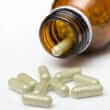Background
- Ornithine is an amino acid found in the human body. It is made when the body disposes of excess nitrogen in the urine.
- Ornithine has been shown to stimulate energy and growth hormone, which makes it of interest to bodybuilders. It has been used to improve performance during exercise. However, studies have shown mixed results when using ornithine hydrochloride to improve exercise performance.
- Ornithine is combined with a compound called amino acid aspartate to improve liver health. Although research supports the use of ornithine for liver problems, more evidence is needed before further conclusions can be made.
References
- Alexander JW, Goodman HR, Succop P, et al. Influence of long chain polyunsaturated fatty acids and ornithine concentrations on complications after renal transplant. Exp.Clin.Transplant. 2008;6(2):118-126. View Abstract
- Boehm G, Muller DM, Beyreiss K, et al. Evidence for functional immaturity of the ornithine-urea cycle in very-low-birth-weight infants. Biol.Neonate 1988;54(3):121-125. View Abstract
- Bucci LR, Hickson JF, Pivarnik JM, et al. Ornithine ingestion and growth hormone release in bodybuilders. NUTR. 1990;10(3):239-244.
- Bucci LR, Hickson JF, Wolinsky I, et al. Ornithine supplementation and insulin release in bodybuilders. Int.J.Sport Nutr. 1992;2(3):287-291. View Abstract
- De Bandt JP and Cynober LA. Amino acids with anabolic properties. Curr.Opin.Clin.Nutr.Metab Care 1998;1(3):263-272. View Abstract
- di Luigi L, Guidetti L, Pigozzi F, et al. Acute amino acids supplementation enhances pituitary responsiveness in athletes. Med.Sci.Sports Exerc. 1999;31(12):1748-1754. View Abstract
- Heinanen K, Nanto-Salonen K, Komu M, et al. Creatine corrects muscle 31P spectrum in gyrate atrophy with hyperornithinaemia. Eur.J.Clin.Invest 1999;29(12):1060-1065. View Abstract
- Kjellman UW, Bjork K, Dahlin A, et al. Insulin(GIK) improves myocardial metabolism in patients during blood cardioplegia. Scand.Cardiovasc.J. 2000;34(3):321-330. View Abstract
- Laidlaw SA. and Kopple JD. Newer concepts of the indispensable amino acids. Am.J.Clin.Nutr. 1987;46(4):593-605. View Abstract
- Opara EC, Mirmalek-Sani SH, Khanna O, et al. Design of a bioartificial pancreas(+). J.Investig.Med. 2010;58(7):831-837. View Abstract
- Rhodes P, Barr CS, and Struthers AD. Arginine, lysine and ornithine as vasodilators in the forearm of man. Eur.J.Clin.Invest 1996;26(4):325-331. View Abstract
- Scaglia F. New insights in nutritional management and amino acid supplementation in urea cycle disorders. Mol.Genet.Metab 2010;100 Suppl 1:S72-S76. View Abstract
- Sikorska H, Cianciara J, and Wiercinska-Drapalo A. [Physiological functions of L-ornithine and L-aspartate in the body and the efficacy of administration of L-ornithine-L-aspartate in conditions of relative deficiency]. Pol.Merkur Lekarski. 2010;28(168):490-495. View Abstract
- Staedt U, Leweling H, Gladisch R, et al. Effects of ornithine aspartate on plasma ammonia and plasma amino acids in patients with cirrhosis. A double-blind, randomized study using a four-fold crossover design. J.Hepatol. 1993;19(3):424-430. View Abstract
- Tuchman M, Lee B, Lichter-Konecki U, et al. Cross-sectional multicenter study of patients with urea cycle disorders in the United States. Mol.Genet.Metab 2008;94(4):397-402. View Abstract







